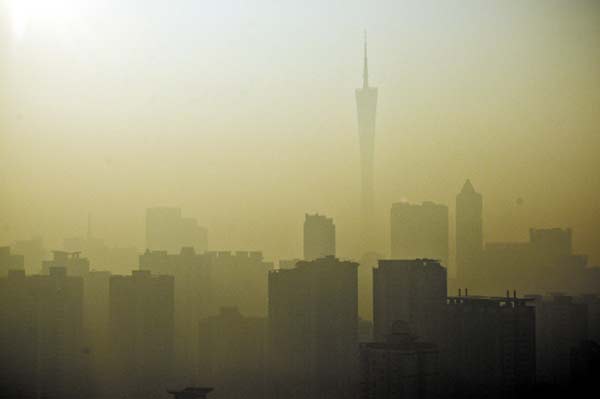
High-rise buildings are partly visible in heavy smog in Guangzhou, South China's Guangdong province, Jan 31, 2014. (Photo/Yangzi Evening News)
Emissions of PM2.5 should be cut by about half on average across China if air quality in most cities is to reach the national standard by 2030, said an official from China's top environmental planning institution at a clean air forum in Beijing on Saturday.
According to the national standard, the concentration of PM2.5 - particulate matter with diameter of less than 2.5 microns that can penetrate the lungs and harm health - should be below 35 micrograms per cubic meter.
Other major air pollutants also need to be reduced drastically, with SO2 dropping by 40 percent, NOX by 45 percent and NH3 by 34 percent, said Wang Jinnan, Vice President of Chinese Academy for Environmental Planning.
More than 300 officials, experts and professionals from central and local governmental institutions, industry associations, universities, international organizations and companies attended the first Bluetech International Clean Air Technology Forum held by Clean Air Alliance of China (CAAC) amid worsening air pollution in China.
They shared ideas on how to combat smog, while some companies were rewarded for developing advanced technologies to improve air quality.
China is expected to take three steps to make air quality in most of the 338 prefecture level cities or above meet the national standard by 2030, said Wang. The first step is to realize a target set in the Airborne Pollution Prevention and Control Action Plan (2013-17) unveiled in September, 2014, which aims to decrease the concentration levels of particulate matter by at least 10 percent by 2017 from the levels in 2012 for the nation's 338 cities.
The other two steps require southern China's Pearl River Delta region to meet the national standard by 2020, followed by eastern China's Yangtze River Delta region and most seriously, northern China's Beijing-Tianjin-Hebei (Jingjinji) region should meet the standard by 2030.
China must take extremely strict emission control measures to realize the three-step plan, said Hao Jiming, an academic at the Chinese Academy of Engineering and a professor at Tsinghua University's School of Environment, at the forum.
The measures include increasing the proportion of the clean energy use, enhancing the efficiency of coal use, reducing vehicle exhausts and Volatile Organic Compounds (VOCs) emissions, and controlling urban population size, said Hao.
China is not alone in treating air pollution. About a half century ago, The local government and residents in Los Angeles, California, the U.S., also struggled in combating photochemical smog and accumulated many air pollution management experiences.
Catherine Witherspoon, former Executive Officer of the California Air Resource Board, delivered a speech called Role of Advanced Technology in Cleaning California Air. Drawing from California's practice, she emphasized the importance of implementing Best Available Control Technology for stationary sources and "Technology-forcing approach" for vehicles.
Best Available Technology is used globally. Axel Friedrich, former division Head of Federal Environmental Agency of Germany, shared his observations on how Best Available Technique system was developed and implemented in the Europe.
Another expert Michael P. Walsh introduced the developments of the clean vehicle technologies in the U.S.. He is the Founding Chairman of the Board of Directors, International Council on Clean Transportation.
In an encouraging sign, Chinese companies were also geared up to use advanced technologies in air pollution prevention and control. They compete with overseas companies for the first year's Bluetech Awards in the areas of diesel emission control technology, VOCs pollution control technology, indoor air pollution purification technology and straw recycle technology.
Bluetech Awards, initiated by CAAC in August, aims to push forward the development and implementation of feasible clean air technology. A total 26 technologies were nominated for the awards among 56 collected technologies from 8 countries across the world including the U.S., French, Germany, Italy, the UK, Australia, Malaysia and China. There are 5 technologies won the Bluetech Awards.


















































